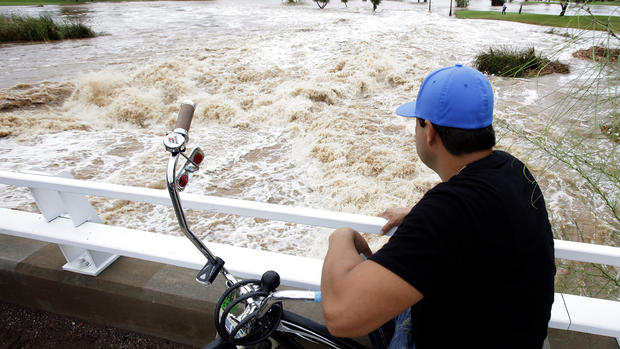Odile forces tourist evacuations in Mexico, targets Arizona next
MEXICO CITY -- Mexico's government airlifted thousands of stranded foreign tourists out of the hurricane-ravaged resort of Los Cabos, as a weakened Odile headed over the Gulf of California Wednesday on a path toward Arizona and a new storm loomed to the south.
The remnants of Odile, which had been downgraded from a Category 3 hurricane to a tropical storm, were expected to reach Arizona Wednesday evening and strike hardest in the Tucson area, though forecasters said Phoenix could get lashed with rain and heavy winds as well.
The U.S. National Hurricane Center said parts of Arizona and New Mexico could receive 6 to 9 inches of rain, and possible flash flooding.
CBS News correspondent Carter Evans reports that Arizona has already seen its fair share of severe weather this season. Last week, the remnants of another powerful Pacific storm - Norbert - caused record flooding.
"I don't need more rain. When I heard there was more rain coming in, I panicked -- horrible," one Arizona woman said.
In Mexico, residents of the resort state of Baja California Sur struggled with a lack of power and drinking water and formed long lines for emergency supplies. There were scattered reports of looting. Tourists, meanwhile, were ferried on military and commercial planes through the Los Cabos international airport, which remained closed to commercial flights due to damage suffered when Odile tore through the area late Sunday and Monday.
Travelers were being flown free of charge to airports in Tijuana, Mazatlan, Guadalajara and Mexico City to catch connecting flights.
Fatai Oshi-Ojuri, a tourist from Oakland, California, who came to Mexico with his girlfriend to celebrate his 30th birthday, was among the first to get out on a Federal Police jet.
He said the airport in Los Cabos was a mess with roof panels and electrical wiring down, and signs and windows shattered.
"That was like a scene from 'The Walking Dead,'" he said by phone from Mazatlan, where he was waiting for an Alaska Airlines flight to Los Angeles.
Officials estimated it would take two days to ferry out the 30,000 tourists who were being put up in temporary refuges or hotel areas converted to shelters. Some 26,000 of those were foreigners, primarily from the United States, Canada and Great Britain.
Thousands in the state of Baja California Sur remained without electricity, water or phone service. A boat was on its way with humanitarian aid, and authorities were working to restore utilities.
Emergency officials in Baja California reported that 135 people were treated for minor injuries. But surprisingly for a hurricane of this intensity there were no reports so far of fatalities directly related to Odile.
But a new storm threatened to whip the region in days to come.
Tropical Storm Polo was projected to grow into a hurricane late by early Thursday and march parallel to the Mexican coast, with a possible brush with Los Cabos by Sunday, though its center was projected to stay off shore.
Polo was located 185 miles (295 kilometers) south of Zihuatanejo with maximum sustained winds of 50 mph (85 kph), and was moving northwest at 12 mph (19 kph). The hurricane center predicted that Polo could become a hurricane by Wednesday night or early Thursday.
The U.S. National Hurricane Center said that by Wednesday morning, Odile had maximum sustained winds near 45 mph (75 kph). It was centered about 65 miles (105 kilometers) south of Puerto Penasco, a tourist town known to many Americans as Rocky Point. It was moving to the northeast near 6 mph (9 kph).
Meanwhile in the central Atlantic, Hurricane Edouard was a Category 1 storm with maximum sustained winds near 90 mph (150 kph). It was far from land, but the Hurricane Center said swells from Edouard would begin affecting parts of the U.S. East Coast north of Florida, likely causing life-threatening rip current conditions.

